Financial Market Bubbles- From Euphoria to Credit Collapse Revulsion
Stock-Markets / Liquidity Bubble Jun 17, 2008 - 10:50 AM GMTBy: John_Mauldin
 What does a bubble look like and how do they end? In this week's Outside the Box, James Montier of Societe Generale in London looks at not only the psychological analysis, but also at the propensity for commentators to continually proclaim the end of the problem and a resumption of business as usual. He includes a fascinating piece from Marc Faber documenting the various quotes about how well the economy was doing from 1928-32. This makes for fun, if a little sobering, reading.
What does a bubble look like and how do they end? In this week's Outside the Box, James Montier of Societe Generale in London looks at not only the psychological analysis, but also at the propensity for commentators to continually proclaim the end of the problem and a resumption of business as usual. He includes a fascinating piece from Marc Faber documenting the various quotes about how well the economy was doing from 1928-32. This makes for fun, if a little sobering, reading.
To quote from his summary: "We have seen the heads of virtually all financial institutions stand up over the last few months and claim the worst is behind us. Why would anyone listen to these people? They didn't see the disaster coming, and yet somehow they are qualified to tell us it is all alright! Perhaps I am just unduly sceptical, but this reeks of a conspiracy of optimism. The recession has barely started, let alone reached its nadir. The market moves of late have all the hallmarks of a classic sucker's rally. This isn't discounting the recovery, this is denial! Far from being behind us, the worst may well still be ahead!"
I think you will find this letter very interesting.
John Mauldin, Editor
Outside the Box
The Road To Revulsion
by James Montier
A couple of months ago I wrote a note arguing that events unfolding the in the US weren't a black swan but rather an example of a predictable surprise (see Mind Matters , 13 March 2008 http://sgresearch.socgen.com /publication/strategy_periodica l(20080313)_408.pdf ). To claim the credit crisis as a black swan is to abdicate all responsibility for its occurrence. I argued that bubbles are a by-product of human behaviour, and that human behaviour is sadly all too predictable.
The details of each bubble are different but the general patterns remain very similar. As Marx said, history repeats itself, the first time as tragedy, the second time as farce. It is the general pattern of debubbling that I wish to explore this week, particularly in the context of the market's apparent attitude that the worst of the problems seem to be behind us.
Bubbles: a framework for analysis
We have long been proponents of the Kindleberger/Minsky framework for analysing bubbles (see Chapters 38 and 39 of Behavioural Investing for all the details). Essentially this model breaks a bubble's rise and fall into five phases as shown below.
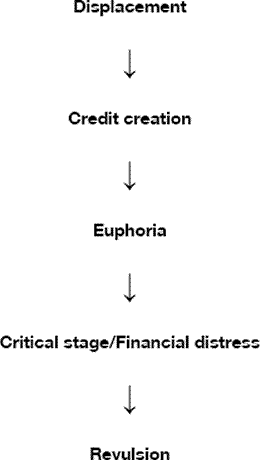
Displacement - The birth of a boom
Displacement is generally an exogenous shock that triggers the creation of profit opportunities in some sectors, while closing down profit availability in other sectors. As long as the opportunities created are greater than those that get shut down, investment and production will pick up to exploit these new opportunities. Investment in both financial and physical assets is likely to occur. Effectively we are witnessing the birth of a boom.
Credit creation - The nurturing of a bubble
Just as fire can't grow without oxygen, so a boom needs liquidity to feed on. Minsky argued that monetary expansion and credit creation are largely endogenous to the system. That is to say, not only can money be created by existing banks but also by the formation of new banks, the development of new credit instruments and the expansion of personal credit outside the banking system.
Euphoria
Everyone starts to buy into the new era. Prices are seen as only capable of ever going up. Traditional valuation standards are abandoned, and new measures are introduced to justify the current price. A wave of overoptimism and overconfidence is unleashed, leading people to overestimate the gains, underestimate the risks and generally think they can control the situation.
Critical stage/Financial distress
The critical stage is often characterised by insiders cashing out, and is rapidly followed by financial distress, in which the excess leverage that has been built up during the boom becomes a major problem. Fraud also often emerges during this stage of the bubble's life.
Revulsion
This is the final stage of a bubble's life cycle. Investors are so scarred by the events in which they participated that they can no longer bring themselves to participate in the market at all.
Bull traps in bear markets
Of course, no debubbling process occurs in a straight line. They are punctuated by electrifying bull runs than end up as bear traps. I first came across the wonderful chart below in Marc Faber's Doom, Boom and Gloom report. It struck such a cord that I had to reproduce it here, taken from Colin Seymour's website.
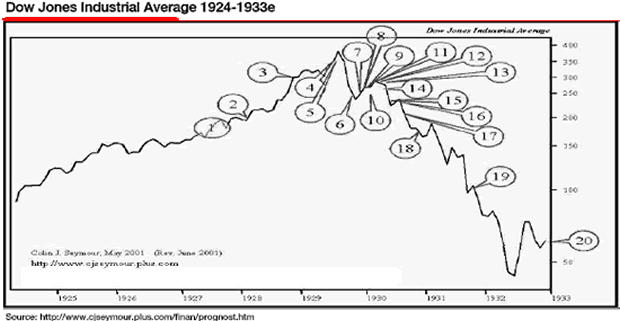
1 "We will not have any more crashes in our time."- John Maynard Keynes in 1927 [NB: The authenticity of this one is a little suspect]
2. "I cannot help but raise a dissenting voice to statements that we are living in a fool's paradise, and that prosperity in this country must necessarily diminish and recede in the near future." - E. H. H. Simmons, President, New York Stock Exchange, January 12, 1928
"There will be no interruption of our permanent prosperity." - Myron E. Forbes, President, Pierce Arrow Motor Car Co., January 12, 1928
3. "No Congress of the United States ever assembled, on surveying the state of the Union, has met with a more pleasing prospect than that which appears at the present time. In the domestic field there is tranquility and contentment...and the highest record of years of prosperity. In the foreign field there is peace, the goodwill which comes from mutual understanding." - Calvin Coolidge December 4, 1928
"When the financial and business history of 1929 is finally written, developments of the past fortnight will occupy a prominent place in what will doubtless be the chronicle of an exceptionally brilliant twelve month period." - The New York Times, July 1929
"It becomes increasingly evident that, in many respects, 1929 will be written into the commercial history of the country as the most remarkable year since the World War in point of sustained demand for goods and services." - The New York Times, August 1929:
4. "There may be a recession in stock prices, but not anything in the nature of a crash." - Irving Fisher, leading U's. economist, New York Times, Sept. 5, 1929
"Stock prices will stay at high levels for years to come, says Ohio economist" - The New York Times, II, Page 7, Col. 2, Oct 13, 1929
5. "Stock prices have reached what looks like a permanently high plateau. I do not feel there will be soon if ever a 50 or 60 point break from present levels, such as (bears) have predicted. I expect to see the stock market a good deal higher than it is today within a few months." - Irving Fisher, Ph.D. in economics, Oct. 17, 1929
The market went into decline until Monday, October 21st, 1929
"He dismissed yesterday's break in the market as a 'shaking out of the lunatic fringe that attempts to speculate on margin.'" - Irving Fisher, The New York Times, Oct. 22, 1929
"Security values in most instances were not inflated"
"The nation is marching along a permanently high plateau of prosperity"
"any fears that the price level of stocks might go down to where it was in 1923 or earlier are not justified by present economic conditions"
- Irving Fisher, speech to a banking group, Oct. 23, 1929
"This crash is not going to have much effect on business."- Arthur Reynolds, Chairman of Continental Illinois Bank of Chicago, October 24, 1929
Flashback to "Black Thursday," Oct. 24, 1929:
Stocks opened moderately steady in price, but traders whose margins were exhausted began selling heavily... at one o'clock the stock ticker was recording prices from half past eleven... stocks dropped 11% intra-day... After a bankers' consortium sent NYSE Vice President Richard Whitney to the stock exchange floor to offer to purchase in the neighborhood of twenty or thirty million dollars' worth of stock at the previous selling price [most likely above their quotations], the market eventually closed with only a 2% loss.
Ref: Only Yesterday: An Informal History of the 1920's, Frederick Lewis Allen, Chap. XIII.
Not long after, the stock market plummeted in two days of panic: October 28 became known as "Black Monday" (13.47% decline in the Dow), and October 29 as "Black Tuesday" (11.73% decline in the Dow). Between October 23rd and November 13th, 1929, the Dow fell by 39%.
"There will be no repetition of the break of yesterday... I have no fear of another comparable decline."- Arthur W. Loasby (President of the Equitable Trust Company), quoted in NYT, Friday, October 25, 1929
"We feel that fundamentally Wall Street is sound, and that for people who can afford to pay for them outright, good stocks are cheap at these prices." - Goodbody and Company market- letter quoted in The New York Times, Friday, October 25, 1929
"The fundamental business of the country, that is production and distribution of commodities, is on a sound and prosperous basis."- President Herbert Hoover, October 25th, 1929
"They have lost a few tail feathers but in time they will grow again, longer and more luxurious than the old ones." - The Wall Street Journal, between Oct 24 and Oct 29, 1929
"The investor who purchases securities at this time with the discrimination that as always is a condition of prudent investing may do so with confidence." - New York Times, October 28, 1929
6. "This is the time to buy stocks. This is the time to recall the words of the late J. P. Morgan... that any man who is bearish on America will go broke. Within a few days there is likely to be a bear panic rather than a bull panic. Many of the low prices as a result of this hysterical selling are not likely to be reached again in many years." - R. W. McNeel, market analyst, as quoted in the New York Herald Tribune, October 30, 1929
"Buying of sound, seasoned issues now will not be regretted" - E. A. Pearce market letter quoted in the New York Herald Tribune, October 30, 1929
"Some pretty intelligent people are now buying stocks... Unless we are to have a panic -- which no one seriously believes, stocks have hit bottom." - R. W. McNeal, financial analyst in October 1929
7. "The decline is in paper values, not in tangible goods and services... America is now in the eighth year of prosperity as commercially defined. The former great periods of prosperity in America averaged eleven years. On this basis we now have three more years to go before the tailspin." - Stuart Chase (American economist and author), NY Herald Tribune, November 1, 1929
"Hysteria has now disappeared from Wall Street."- The Times of London, November 2, 1929
"The Wall Street crash doesn't mean that there will be any general or serious business depression... For six years American business has been diverting a substantial part of its attention, its energies and its resources on the speculative game... Now that irrelevant, alien and hazardous adventure is over. Business has come home again, back to its job, providentially unscathed, sound in wind and limb, financially stronger than ever before." Business Week, November 2, 1929
"...despite its severity, we believe that the slump in stock prices will prove an intermediate movement and not the precursor of a business depression such as would entail prolonged further liquidation..." - Harvard Economic Society (HES), November 2, 1929
8. "... a serious depression seems improbable; [we expect] recovery of business next spring, with further improvement in the fall." - HES, November 10, 1929
"The end of the decline of the Stock Market will probably not be long, only a few more days at most." - Irving Fisher, Professor of Economics at Yale University, November 14, 1929
"In most of the cities and towns of this country, this Wall Street panic will have no effect." Paul Block (President of the Block newspaper chain), editorial, November 15, 1929
"Financial storm definitely passed." Bernard Baruch, cablegram to Winston Churchill, November 15, 1929
9. "I see nothing in the present situation that is either menacing or warrants pessimism... I have every confidence that there will be a revival of activity in the spring, and that during this coming year the country will make steady progress." - Andrew W. Mellon, U's. Secretary of the Treasury December 31, 1929
"I am convinced that through these measures we have reestablished confidence." - Herbert Hoover, December 1929
"[1930 will be] a splendid employment year." - U's. Dept. of Labor, New Year's Forecast, December 1929
10. "For the immediate future, at least, the outlook (stocks) is bright." - Irving Fisher, Ph.D. in Economics, in early 1930
11. "..'there are indications that the severest phase of the recession is over..." - Harvard Economic Society (HES) Jan 18, 1930
12. "There is nothing in the situation to be disturbed about." -Secretary of the Treasury Andrew Mellon, Feb 1930
13. "The spring of 1930 marks the end of a period of grave concern...American business is steadily coming back to a normal level of prosperity." - Julius Barnes, head of Hoover's National Business Survey Conference, Mar 16, 1930
"... the outlook continues favorable..." - HES Mar 29, 1930
14. "... the outlook is favorable..." - HES Apr 19, 1930
15."While the crash only took place six months ago, I am convinced we have now passed through the worst -- and with continued unity of effort we shall rapidly recover. There has been no significant bank or industrial failure. That danger, too, is safely behind us." -Herbert Hoover, President of the United States, May 1, 1930
"...by May or June the spring recovery forecast in our letters of last December and November should clearly be apparent..." - HES May 17, 1930
"Gentleman, you have come sixty days too late. The depression is over."- Herbert Hoover, responding to a delegation requesting a public works program to help speed the recovery, June 1930
16. "... irregular and conflicting movements of business should soon give way to a sustained recovery..." - HES June 28, 1930
17. "... the present depression has about spent its force..." - HES, Aug 30, 1930
18. "We are now near the end of the declining phase of the depression." - HES Nov 15, 1930
19."Stabilization at [present] levels is clearly possible." - HES Oct 31, 1931
20. "Executive Order 6102 Forbidding the Hoarding of Gold Coin, Gold Bullion and Gold Certificates
By virtue of the authority vested in me by Section 5(b) of the Act of October 6, 1917, as amended by Section 2 of the Act of March 9, 1933, entitled "An Act to provide relief in the existing national emergency in banking, and for other purposes", in which amendatory Act Congress declared that a serious emergency exists, I, Franklin D. Roosevelt, President of the United States of America, do declare that said national emergency still continues to exist and pursuant to said section to do hereby prohibit the hoarding of gold coin, gold bullion, and gold certificates within the continental United States by individuals, partnerships, associations and corporations and hereby prescribe the following regulations for carrying out the purposes of the order...
All persons are hereby required to deliver on or before May 1, 1933, to a Federal Reserve bank or a branch or agency thereof or to any member bank of the Federal Reserve System all gold coin, gold bullion, and gold certificates now owned by them or coming into their ownership on or before April 28, 1933, except the following:
- Such amount of gold as may be required for legitimate and customary use in industry, profession or art within a reasonable time, including gold prior to refining and stocks of gold in reasonable amounts for the usual trade requirements of owners mining and refining such gold.
- Gold coin and gold certificates in an amount not exceeding in the aggregate $100.00 belonging to any one person; and gold coins having recognized special value to collectors of rare and unusual coins.
- Gold coin and bullion earmarked or held in trust for a recognized foreign government or foreign central bank or the Bank for International Settlements.
- Gold coin and bullion licensed for the other proper transactions (not involving hoarding) including gold coin and gold bullion imported for the re-export or held pending action on applications for export license..." Franklin D. Roosevelt, The Whitehouse April 5, 1933 20 May 2008
The comments made every time the market rallies are characterised by the ever-present optimism that we have discussed many times. I suspect that is exactly what we are witnessing currently.
The first wave of concerns created by the bursting the housing/credit bubble (and make no mistake they are two sides of the same coin) is subsiding. The optimists believe (or at least hope) that the worst is now over. Indeed the probability of a recession in 2008 has dropped to 39% on the Intrade contract!
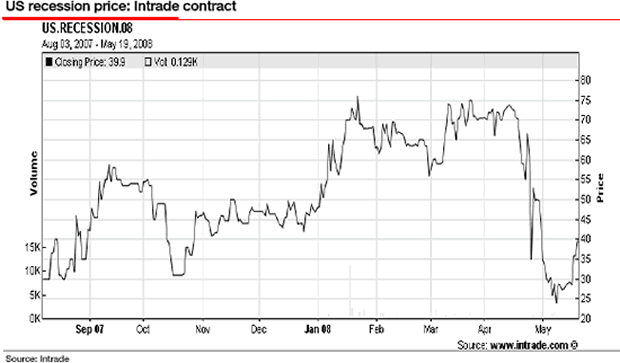
However, from our perspective such sanguinity is likely to be misplaced. The slowdown in the US is barely starting. The charts below show that both the demand and supply for .credit. are evaporating. This effective shutdown of both sides of the market should be a serious concern for monetary policy makers, as it is one of the hallmarks of a liquidity trap situation.
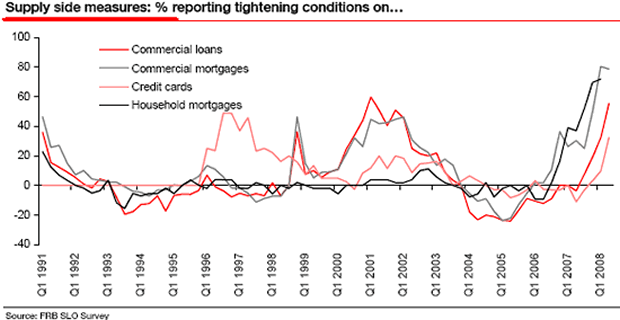
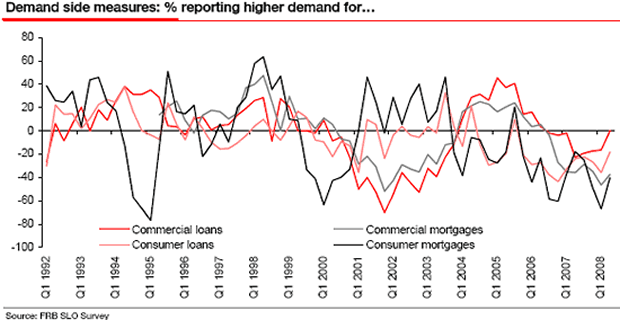
Note in particular how widespread the lack of demand for credit is, as well as the supply! This isn't just about the housing market. Obviously demand for mortgages (both commercial and residential) is lacking, but so is the demand for consumer credit, and corporate credit. This doesn't bode well for the outlook.
The underlying asset adjustment is likely to have much further to run as well. The chart below shows the developments in US house prices and Japanese land prices during their bubble and burst. The point of this chart isn't to say that US prices will follow Japanese prices, but rather to illustrate the long drawn out nature of the healing that has to occur. Indeed, one client recently asked me if this was worse than the S&L crisis. To my mind it is much worse, as securitisation was part of the solution to the S&L problems, whereas it has been part of the problem in the build-up in this bubble.
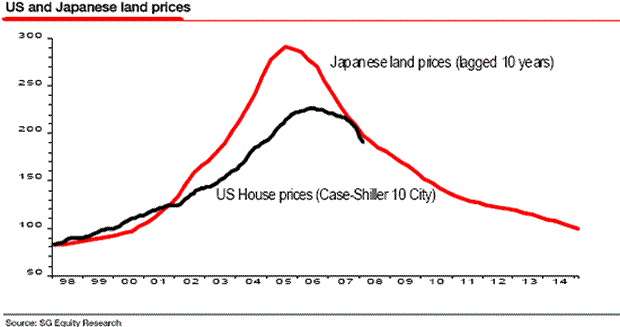
Indeed, one of the lessons that should be learnt from the Japanese experience is that the banks were second round losers, a point made by Albert Edwards recently (see 3 April http://sgresearch.socgen.com /publication/strategy_update (20080403)_cc0.pdf Global Strategy Weekly ). They didn't really begin to underperform the rest of the market until the second Japanese recession of its debubbling process. They really started to suffer when their consumers (Japan Inc) started to struggle.
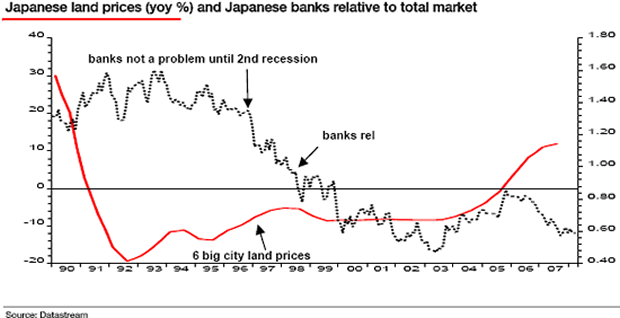
From a market perspective, financials remain an exceptionally large component of the market itself. As the chart below shows, today's 17% of market cap may be well off the high of nearly 25% but remains a long way above the levels before this bubble started.
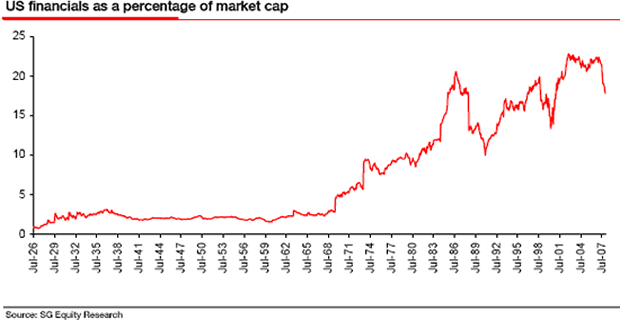
One of the other lessons of importance from Japan is that it is never the stocks that led you into the bubble that lead you out. For instance, in Japan's post bubble environment it was the capital-starved autos and electricals that were the winners. Just as the US market recovery after the dot com bubble wasn't led by tech but by mining, material and financials. Those deprived of capital do best in the aftermath of a bursting bubble, not those gorged on it. This argues that it isn't likely to be financials that lead us into any sustained rally.
This makes it all the harder to understand the way in which investors have been cheering the rights issues/capital raisings that financial firms have been carrying out. I recently described investors. responses to rights issues as the investment equivalent of being mugged and then turning around and saying thank you to the perpetrator (and perhaps offering to take them to the cash point and get some more money out for them).
The chart below may just give some pause for thought. It comes from a study by Capstaff et al 1 . They study the long-term performance of stocks conducting rights issues in the UK between 1986 and 1995. In particular, they split out the evidence in the pre 1991 and post 1991 periods. This is interesting because it reveals two different motives for a right issue. During the first period, it appears managers issued more equity to take advantage of high valuations. However, the second period reflects a more separate need for cash brought on by the last UK housing recession.
Regardless of the motive, the outcome is clear from even a cursory glance at the chart below. Rights issues are bad news for investors. The poor performance of firms conducting rights issues prior to the issue itself is clearly observable for the 1991-1995 sub-period. Even more noticeable is the increased underperformance once the rights issue is over. If history is any guide, investors cheering such issues now are likely to end up severely disappointed at the end of the day.
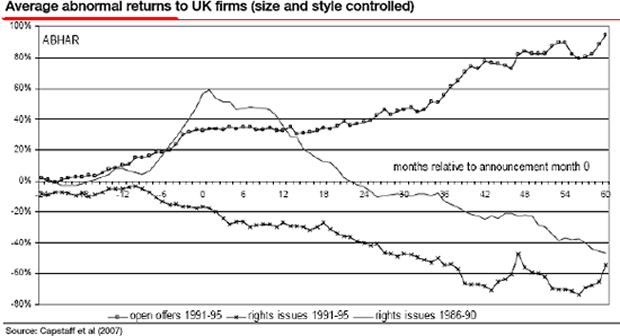
From our perspective, the market is enjoying a sucker's rally. The road to revulsion is likely to witness many such events, but the recession reality is only just unfolding. Far from being behind us, the worst may still be ahead!
Footnotes:
1 Capstaff, Ngatuni and Marshall (2007) Long-term performance following rights issues and open offers in the UK, available from www.ssrn.com
Your still thinking sell in May and go away analyst,
By John Mauldin
John Mauldin, Best-Selling author and recognized financial expert, is also editor of the free Thoughts From the Frontline that goes to over 1 million readers each week. For more information on John or his FREE weekly economic letter go to: http://www.frontlinethoughts.com/learnmore
To subscribe to John Mauldin's E-Letter please click here:http://www.frontlinethoughts.com/subscribe.asp
Copyright 2008 John Mauldin. All Rights Reserved
John Mauldin is president of Millennium Wave Advisors, LLC, a registered investment advisor. All material presented herein is believed to be reliable but we cannot attest to its accuracy. Investment recommendations may change and readers are urged to check with their investment counselors before making any investment decisions. Opinions expressed in these reports may change without prior notice. John Mauldin and/or the staff at Millennium Wave Advisors, LLC may or may not have investments in any funds cited above. Mauldin can be reached at 800-829-7273.
Disclaimer PAST RESULTS ARE NOT INDICATIVE OF FUTURE RESULTS. THERE IS RISK OF LOSS AS WELL AS THE OPPORTUNITY FOR GAIN WHEN INVESTING IN MANAGED FUNDS. WHEN CONSIDERING ALTERNATIVE INVESTMENTS, INCLUDING HEDGE FUNDS, YOU SHOULD CONSIDER VARIOUS RISKS INCLUDING THE FACT THAT SOME PRODUCTS: OFTEN ENGAGE IN LEVERAGING AND OTHER SPECULATIVE INVESTMENT PRACTICES THAT MAY INCREASE THE RISK OF INVESTMENT LOSS, CAN BE ILLIQUID, ARE NOT REQUIRED TO PROVIDE PERIODIC PRICING OR VALUATION INFORMATION TO INVESTORS, MAY INVOLVE COMPLEX TAX STRUCTURES AND DELAYS IN DISTRIBUTING IMPORTANT TAX INFORMATION, ARE NOT SUBJECT TO THE SAME REGULATORY REQUIREMENTS AS MUTUAL FUNDS, OFTEN CHARGE HIGH FEES, AND IN MANY CASES THE UNDERLYING INVESTMENTS ARE NOT TRANSPARENT AND ARE KNOWN ONLY TO THE INVESTMENT MANAGER.
John Mauldin Archive |
© 2005-2022 http://www.MarketOracle.co.uk - The Market Oracle is a FREE Daily Financial Markets Analysis & Forecasting online publication.



